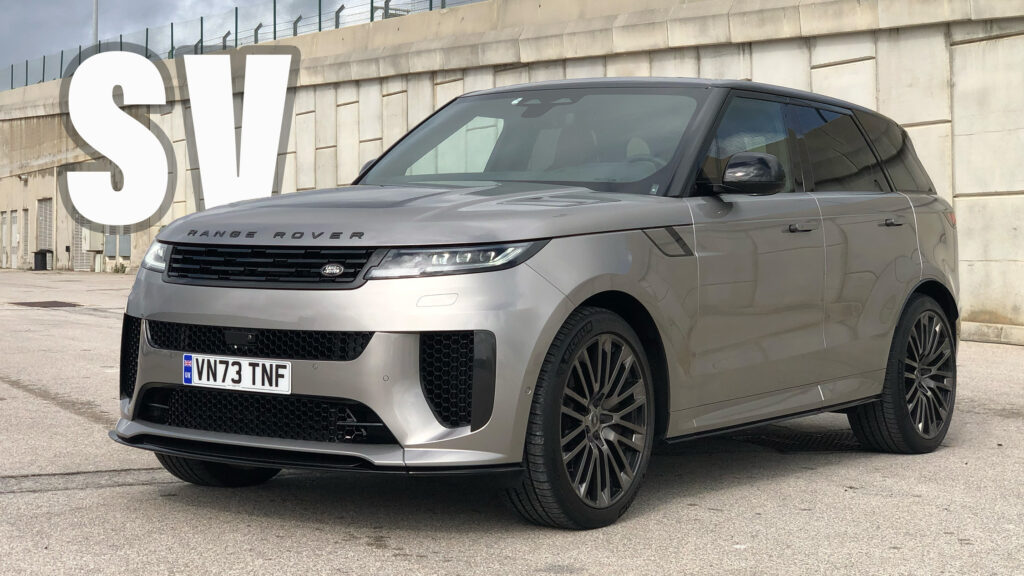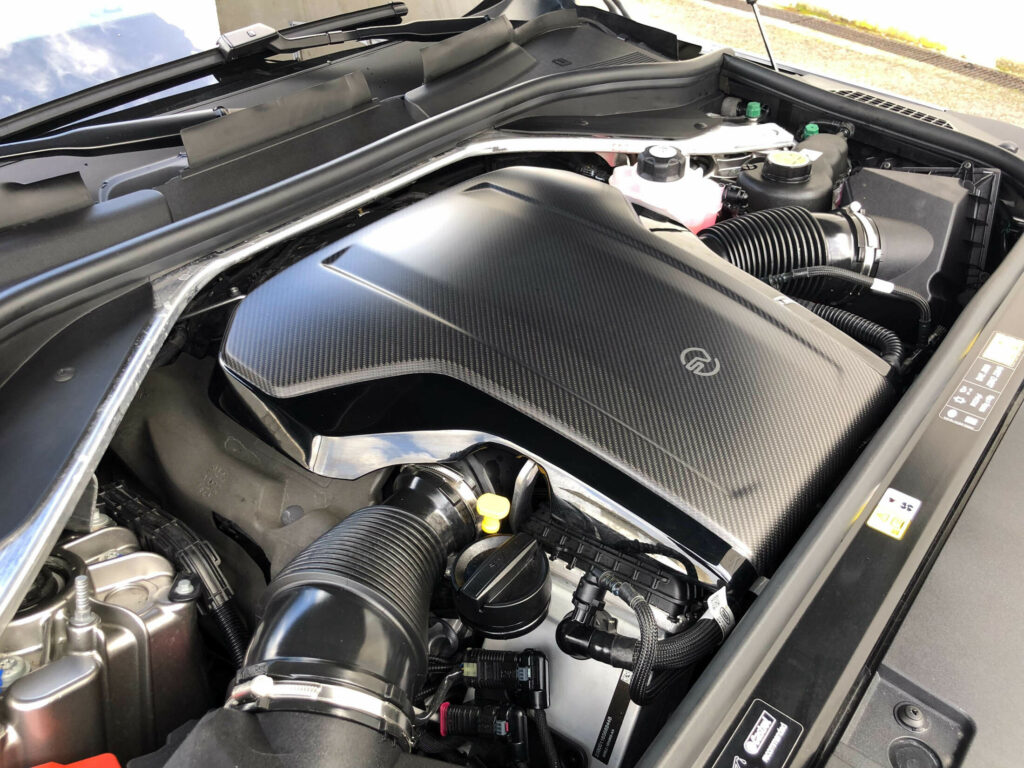 –>
–> 
A Smart 6D suspension and the BMW M powertrain transform ride and handling over stock Sport, but at a huge financial cost
6 hours ago
–>
The performance SUV world has changed beyond recognition since the old Range Rover Sport SVR was launched in 2014. Back then, anything over 500 hp (507 PS) was enough to thrust a high-rise hot rod into the big league. But back then, the big league wasn’t really that big. It didn’t feature a Lamborghini Urus, Aston Martin DBX or Ferrari Purosangue, and even Bentley’s Bentayga, which feels like it’s been around forever, was still months from its global debut.
So the SVR’s replacement, the new SV, needed a big injection of both power and luxury to make it a viable rival for models like the Urus and DBX each year, whose success has transformed the fortunes of both automakers. Having the latest Range Rover Sport that landed in 2022 as a starting point, is a big leg-up here. The third-gen Sport looks, and more importantly feels, expensive. It’s got an infotainment system that for once isn’t two generations behind its rivals’ equipment, and the new SV takes its V8 powertrain from BMW’s M division.
A BMW Motorsport heart

QUICK FACTS
The stoutest engine available in the regular Sport until recently was the 523 hp (530 PS) 4.4-liter BMW N63 V8 fitted to the P530, but that’s been dropped, and the new top dog is the P550e, a PHEV variant of JLR’s 3.0-liter six that makes 542 hp (550 PS). The SV also takes a BMW 4.4, but it’s the S63 M version that comes equipped with mild-hybrid tech and pumps out 626 hp (635 PS) along with 553 lb-ft (750 Nm) of torque.
advertisement scroll to continue
That compares with 567 hp (575 PS) and 516 lb-ft (700 Nm) for the final version of the old SVR, though you could be forgiven for thinking the gulf is greater. Not from the noise, which sounds suitably growly in isolation (especially with the active exhaust flaps open) and suits the SV’s classy presentation, though can’t match the thunder of SVR’s 5.0-liter supercharged V8.
But from the way it pulls. You needed 4.3 seconds to hit 60 mph (96 km/h) in the 162 mph (260 km/h) SVR; its 180 mph (290 km/h) replacement gets there in three-six, compressing you into the fancy SV-badged chair as good as a middleweight 911 can, and meaning the brick-shaped Brit is far faster against the clock than a base DBX (4.3 seconds).
Stealthy, but plenty of subtle SV design cues
The visual clues to that extra muscle are relatively subtle. There are unique 23-inch wheels, a quartet of round, carbon-tipped exhaust tailpipes and a much deeper front bumper that makes it look like a regular Sport’s jaw just hit the asphalt when it heard how much more the SV cost. You can get into a base Sport SE for $83,600 / £83,620 and the non-SV lineup tops out at $118,200 / £98,360 for the Autobiography. But the SV will set you back $181,775 in the U.S. and £171,460 in the UK.
Related: 2024 Range Rover Sport SV Is A 180 MPH Super SUV With A 626HP BMW V8 And Music-Jiggling Seats
That’s a hefty premium, especially considering the last of the SVRs was listed at $119k / £100k, though there are a couple of points to mention here. One is that while the UK price pitches the SV close to the Urus, Bentayga and DBX, in the U.S. those SUVs all cost over $200k. The other point is that we’re talking here about the SV First Edition. That’s the only kind of SV available for 2024, and they’re all spoken for. The ordinary SV doesn’t drop until later this year in time for the 2025 season, but when it does it should be more affordable.
Seats like a 4D movie theater’s
But we suspect that making it more affordable will mean relegating a few of the First Edition’s fancy bits to the options list, including the Body and Soul Seats that use in-built speakers to help you ‘feel’ as well as hear your music. It’s an interesting idea, but I’m not entirely sure I liked the sensation or whether I’d use them after the initial excitement and novelty had worn off. I didn’t get a chance to try the wellness mode, which matches vibrations to stored audio tracks to either calm or invigorate you. Maybe that’s better. Or maybe it’s all a bunch of gadgety nonsense that no one needs.
We also wonder if the 2025 SVs might ask you to pay extra for the First Edition’s carbon hood, which features visible weave on Flux Silver and Obsidian Black cars and is painted body color on Carbon Bronze SVs. The Bronze cars command a $19,150 / £13,900 premium on account of their matte paint, 23-inch carbon wheels and carbon brakes with yellow calipers. You can also spec the silver and black cars with the same wheel and tire package. It saves a massive 154 lbs (70kg) of unsprung mass, but costs $19,150/£13,900.
Brakes: no need to splash out
advertisement scroll to continue
Don’t bother, we say. We drove both and the stock brakes work fine, offering epic stopping power when asked to haul the 5,645 lbs (2560 kg) Sport down from high speed, and plenty of feel. And it shouldn’t come as any surprise to learn that the SV’s chassis can cope with extra mass of the steel and alloy hardware at each corner when you hear that Land Rover’s engineer’s optimized the suspension to work with the standard bits that most people will buy, and not the carbon ones only a few will pick.
It’s that chassis that’s really the star of the SV show. While the old SVR was just a Sport with a ton more horses and some basic suspension work, the SV gets an entirely different chassis and steering setup. The first thing you notice, even at parking speeds, is the quicker steering rack. Combined with the rear-wheel steering that already features on some lesser Sports, it makes the SV feel surprisingly wieldy in town, and incredibly agile out of it.
The rear wheels still do the in-phase, out-phase thing at high and low speeds, but the point at which they switch from turning the opposite way to the fronts to the same direction has been increased from 31 mph (50 km/h) to around 80 mph (130 km/h), meaning it feels hyper-alert right up to freeway speeds. It’s definitely less relaxing to drive than a stock Range Rover Sport because of this, but it manages to stay on the right side of nervous, and you quickly get used to how little wrist action is needed to tip the SV into a curve.
Shocks provide a surprise in corners
But more significant than the steering is the 6D damper system. In addition to the usual air springs the SV features four special shocks that are diagonally connected. Plumbing them in requires a staggering 82 feet (25 m) of pipework, but they allow Land Rover to entirely ditch conventional anti-roll bars, which has benefits both on and off road.
In the dirt you get a big boost in wheel articulation, and on the solid stuff you enjoy a smooth ride on uneven surfaces in Comfort mode, and more roll-resistance torque than even an electric motor-controlled anti-roll bar setup can deliver in the more driver-focused settings. And it’s not just roll that’s kept in check, but pitch and dive, too. If you’ve ever goosed a powerful SUV from one set of lights and had to stomp on the brakes before the next set, you’ll know that’s a big deal in big, heavy luxo-trucks.
Good ride comfort, incredible control in SV mode
To be honest, the combination of the quick steering and a body that wants to stay level no matter what is slightly unnerving at first. SUVs aren’t meant to feel this planted. You only get the merest hint of this ability in Comfort mode, which doesn’t exactly fall apart in quick driving, but is obviously geared towards gentle use and delivers an impressively supped ride considering there are twenty-threes tucked under the arches. Step up to Dynamic, or the SV-only SV mode, and the difference between this SUV and a regular Sport is night and day. Dynamic works on pretty much any kind of twisty road, only sacrificing a little compliance for far better body control. But if the road is German smooth, or you’ve got tired of the stability system having a flap even when you’ve supposedly switched it out, you need to reach for the SV button on the steering wheel’s bottom spoke.
Do that and the twin speedo and rev counter dials are replaced by a central tacho that’s flanked by a turbo boost graph and g meter. Pointless but fun, and slightly less crass than the red lighting now emitted from the transparent shift paddles. But that’s all garnish. What matters is the way you can fling the SV around once those mode tell-tales have appeared. Even on damp roads and on Michelin Pilot Sport all-season rubber (a sticky Michelin Pilot Sport S5 will be available as an alternative for 2025), there’s stacks of front-end bite. And those trick dampers give the rear end enough support that you can really lean on rear tires that are wider (305/35) at the back than the front (285/40) for the first time on a Range Rover.
Keep the pedal pinned and you can even slide the SV on the exit of a bend because the transmission allows up to 100 percent of the drive to turn the back axle, unlike the old SVR, which had a fixed 50:50 split. You’re going to need a bit of room though. Most of the really big drifts you might have seen the development guys performing on video clips on track required a ton of momentum on the way into the curve, with a dab of brakes to really lock the nose onto the apex and set the tail free.
Fun on the track, but also fun where it really counts
Few owners are really going to drive like that, or take one on track, like we did at Portugal’s Portimao, but that’s okay. You don’t need to do either to appreciate how much more fun and capable the SV is than an ordinary Range Rover Sport. The question is, does that extra agility and performance, plus the presence of the only V8 option in the lineup, really justify a $62k/£73k premium over an Autobiography that doesn’t really look much different, inside and out?
The buyers who snapped up the entire allocation of First Edition SVs clearly thought so, and though it looks expensive for a Range Rover Sport, you could argue that the SV also looks good value next to an entry level DBX, which is more expensive, less powerful, much slower and has a ridiculously outdated media system.
We really liked the SV in First Edition trim, but when the regular SV is unveiled for the 2025 model year, hopefully complete with all the mechanical goodies that make this car great, and minus a chunk of sticker price and some of the gadgets we could happily live without, it’s going to massively undercut its Aston and Lamborghini rivals and become an even more desirable proposition.
Photos Chris Chilton / Carscoops, Land Rover



